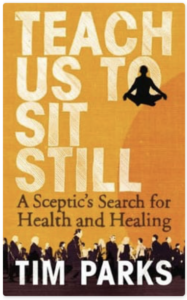‘Teach us to Sit Still’ is Tim Parks seminal book on his journey through pelvic pain
I am delighted to bring you this short interview with author Tim Parks. Tim is well known for his seminal book “Teach us to Sit Still.” This ground breaking title is a very frank, open and honest account of his battle with pelvic pain. It is a real pleasure to have Tim talk about his recovery from pelvic pain, what helped him on this journey and consider the internet and the taboo nature of pelvic pain.
(You will find the questions in bold type, Tim’s answers in regular type and some of my comments in italic)
How is your pelvic pain these days – what causes flare ups if any and how do you manage symptoms if needs be?
I had this condition for about five years, from when I was 49 to 54. Now, at 64, I very rarely have any pain. The two or three flare-ups I have had in recent years were clearly related to periods of stress and anxiety, usually coming at the end of those periods. I find if I react with philosophy, take it easy and take a lot of relaxing walks, things gradually return to normal.
Understanding the link to stress and distress is a major part of successful, long term recovery from pelvic pain. Life is stressful. Life is busy. Life can throw all sorts of challenges up. How we manage and how we react to these is central to our recovery from pelvic pain. A great way of identifying things that cause us stress/distress and things that calm us and make us feel more normal can be found here

In your book “Teach us to sit still” you used meditation as part of your recovery plan. What are your views on the mind body link in pelvic pain and do you have any advice for patients who are dubious of the benefits of meditation?
Mind-body link seems an old fashioned way of putting it, as if there were ever two separate entities, mind and body. It’s the same package. I suppose if CCP is the direct result of a permanently tensed pelvic floor, a tension caused by the way we live, meditation offers two simple benefits. It allows for a deep relaxation of the muscles and leads to a less anxious approach to life, which is what causes the tension in the first place. So it addresses both symptom and cause. But again, that deep relaxation is one with the change of attitude, the two don’t exist separately.
The mind body approach is indeed very dated now. This separatist, dualism model was born from some of Renee Decartes’ work way back in the 17th century, particularly his work “Treatise on Man.” Modern pain science approaches address the patient as a whole, without separation (mind and body). George Engels ‘BioPsychoSocial Model.’ Ron Melzack’s ‘Body, Self Neuromatrix‘ and Louis Giffords’ Mature Organism Model‘ have significantly changed my approach to treating patients. You can read more on this here
Male pelvic pain is still considered a very taboo subject, with many suffering in total isolation. Your book certainly provided many sufferers with a sense that they are not alone in their experiences, myself included. How do we change this taboo and make pelvic pain more acceptable to talk about and what would the upsides of this be?
Is that really still the case? If it is it need not be so. We make our own prisons and the door is there to be opened. There’s no lock on it. Perhaps the problem is that we’re attached to a logic of achievement, we want to seem winners, and someone admitting to this kind of problem fears coming across as a loser. But the problem as I see it is in the sufferer, not the society. It is a fear that is part of the illness. Again, this is a problem that simply disappears over the long term with meditation practise. It comes to seem absurd not to be honest about it.
I see many, many patients who keep their pelvic pain to themselves. Some patients do not even tell their partners about what they endure each and every day! It is essential to seek help and support. Pelvic pain is not something to be embarrassed about. I encourage all of my patients to talk openly and freely about their pain. It can make a difference in finding the right support and guidance
Our pelvic pain symptoms both began before Dr Google was available at out finger tips. What impact do you think the internet has on pelvic pain patients wellbeing and recovery?
Google is a wonderful tool and a dangerous trap, depending how you use it. It was through Google that I eventually found Dr Wise’s famous book and began to get a sense of the beast I was dealing with. So I am thankful to it. On the other hand, if you’re inclined to be fearful, Google can feed those fears in dramatic fashion. So the important thing is to approach the search engine with a cool head… And of course if you can do that you are already on the way to health.
Consulting Dr Google about mens health issues is significantly on the rise. Many men find it too embarrassing to discuss their issues with health care providers. Or, they don’t find they are well supported by GP’s or Urologists and therefore turn to the internet for help
Do you have any take home pearls of wisdom for patients currently suffering with Pelvic Pain?
Pearls of wisdom? I don’t know. Don’t be angry, don’t be fearful. It was important for me when I understood that I didn’t have cancer, it wasn’t a disease in the sense of an invasion of the body. And it could be cured, if only I accepted that it would be a slow process of learning how to relax and reduce tension. That thought allowed me to take it easier, and taking it easier, the pain is already somewhat more bearable. In the long run, however, I believe one has to change, change profoundly, in order to shake off this condition. It is no good imagining you can find a cure, kill the disease and then go on as before.
It sounds like a cliche, but getting over pelvic pain is a process. Pain occurs in the body for a reason. Quite often it is telling us we are doing too much of something or too little of something else. If we do not change then our bodies will stop us in our tracks. They will literally kick us in the b******s to make sure we do stop and pay attention. More on that here
Thank you once again to Tim for his short Q&A on pelvic pain. I know many, many men out there will benefit from your words
………
Although Teach us to sit still was published in 2011 it is a book I still refer many of my patients to read. I encourage patients to be open and honest about what they are going through. I find that the more a patient is able to verbalise their journey the more I can understand and assist them on their path to recovery. Tim epitomises this transparency in his book. It is good to talk. It is good to be honest with ourselves and our friends and family. If you haven’t already read it I strongly encourage you to do so.
Pelvic Pain Q&A Series:
Sandy Hilton, Dr of Physiotherapy. Pelvic health expert
Nick Woods, clinical psychologist and sufferer of pelvic pain
Robert Wells, author of ‘Back, Sack and Crack (and Brain)’ and sufferer of pelvic pain
Jiva Masheder, mindfulness instructor
Tim Parks, author of “Teach us to sit still’ and pelvic pain sufferer
Meg Burgess, specialist nurse at Prostate Cancer UK
Bert Messelink, vice chairman of the European association of urology
Carl Giardinazzo, former director of the Pelvic Pain Foundation Australia and pelvic pain sufferer
Read my interview with Laura Rathbone on Acceptance and Commitment Therapy here

